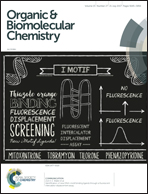Exploiting the biosynthetic machinery of Streptomyces pilosus to engineer a water-soluble zirconium(iv) chelator†
Abstract
The water solubility of a natural product-inspired octadentate hydroxamic acid chelator designed to coordinate Zr(IV)-89 has been improved by using a combined microbiological-chemical approach to engineer four ether oxygen atoms into the main-chain region of a methylene-containing analogue. First, an analogue of the trimeric hydroxamic acid desferrioxamine B (DFOB) that contained three main-chain ether oxygen atoms (DFOB-O3) was generated from cultures of the native DFOB-producer Streptomyces pilosus supplemented with oxybis(ethanamine) (OBEA), which competed against the native 1,5-diaminopentane (DP) substrate during DFOB assembly. This precursor-directed biosynthesis (PDB) approach generated a suite of DFOB analogues containing one (DFOB-O1), two (DFOB-O2) or three (DFOB-O3) ether oxygen atoms, with the latter produced as the major species. Log P measurements showed DFOB-O3 was about 45 times more water soluble than DFOB. Second, a peptide coupling chain-extension reaction between DFOB-O3 and the synthetic ether-containing endo-hydroxamic acid monomer 4-((2-(2-aminoethoxy)ethyl)(hydroxy)amino)-4-oxobutanoic acid (PBH-O1) gave the water soluble tetrameric hydroxamic acid DFOB-O3–PBH-O1 as an isostere of sparingly water soluble DFOB–PBH. The complex between DFOB-O3–PBH-O1 and natZr(IV), examined as a surrogate measure of the radiolabelling procedure, analysed by LC-MS as the protonated adduct ([M + H]+, m/zobs = 855.2; m/zcalc = 855.3), with supporting HRMS data. The use of a microbiological system to generate a water-soluble analogue of a natural product for downstream semi-synthetic chemistry is an attractive pathway for developing new drugs and imaging agents. The improved water solubility of DFOB-O3–PBH-O1 could facilitate the synthesis and purification of downstream products, as part of the ongoing development of ligands optimised for Zr(IV)-89 immunological PET imaging.



 Please wait while we load your content...
Please wait while we load your content...